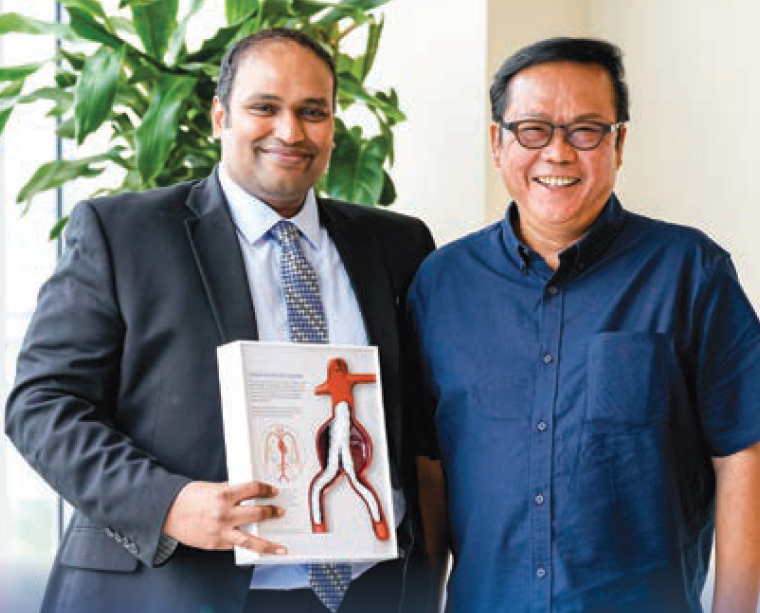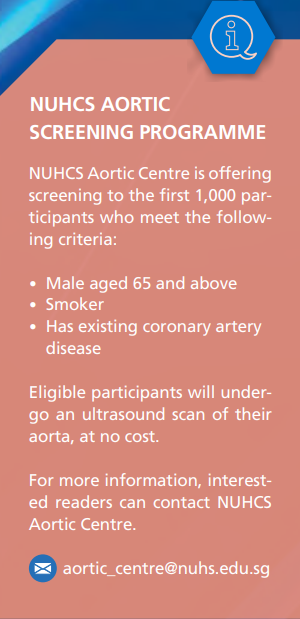A Ticking Time Bomb
Singapore’s first large scale aortic screening programme
to detect fatal conditions
PULSE Issue 41 | July 2023
Beginning from the lower-left chamber of the heart, the aorta looks
like a candy cane, arching upwards a short distance before running
downwards through the chest cavity into the abdomen. It is the largest blood vessel carrying oxygen-rich blood from the heart to vital
organs throughout the body. As the body’s main blood supply, a diseased or damaged aorta could
lead to a medical emergency of massive internal bleeding if not attended to immediately. Common conditions which affect the aorta
include an aneurysm or a dissection.
Aortic Aneurysms
Aortic Aneurysms are mainly caused by a weak area in the aorta that
results in a bulge or a swelling. The bulge can get bigger over time
with the danger of bursting (rupture). Treatment options depends
on the size of the bulge and how fast it is growing.
Aortic Dissection
An Aortic Dissection refers to a tear along the elastic wall of the aorta, which can lead to massive and rapid blood loss if the tear completely dissects (cuts through) the aorta.

Unfortunately, both conditions do not have any obvious symptoms
until it is at the risk of rupture and death. This explains why these
deadly conditions are often diagnosed when patients are being
screened for other conditions, and the swelling of the aorta is being
discovered incidentally.
Mr Donald Teo experienced persistent and excruciating pain in his
lower back that did not seem to go away even after taking painkillers, thus affecting his sleep and daily activities. When he finally
sought help from a General Practitioner (GP), he was immediately admitted to the National University Hospital (NUH) Emergency
Department where it was discovered that his aorta had a leak that
caused the severe pain.
Following the advice of his doctor, he immediately proceeded
with a minimally invasive endovascular repair, where a stent was
placed in his leaking aorta to reduce the bulge and and minimise
the chance of rupture.
Endovascular repair requires regular follow-up visits with an aorta
specialist as problems after the procedure may not show any symptoms. Hence, follow-up checks are important to ensure that no relapse occurs.
In Mr Teo’s case, his bulge reduced
to half in size over two years after
having the stent first inserted in his
abdominal aorta.
The goal of treatment is to avoid
a rupture, as research has shown
that less than half survive for patients who are suffering from a
ruptured aorta.
The only way to prevent a rupture
is to detect the Aneurysm or Dissection early through screening, done
through an ultrasound or preferably, Computed Tomography (CT)
scans where a dye is inserted intravenously to capture an image inside
the body.
If detected early, the treatment for
Aortic Aneurysms or Dissections
could be managed with medication or monitored with a "wait-and-see" approach, depending on
where the Aneurysm or Dissection
occurs, its size and the likelihood
of rupture. In some people, Aneurysms can remain small and not
pose the risk of rupture.
It is not clear why and how fast
Aneurysms or Dissections grow.
However, risk factors such as being
male, having hypertension, and being a smoker can increase the risk
of rupture. Genetics seem to play a
role as well.
 NUHCS Aortic Screening Programme
NUHCS Aortic Screening Programme
To better understand why and how
these conditions occur, NUHCS is currently conducting a study where an
aorta screening will be be offered
to participants.
As early detection will help save
lives, NUHCS also hopes to better
identify individuals at high-risk of
a rupture in their aorta through
this study.
Data collected from this study
will further evaluate the necessity of a collaboration with the
Ministry of Health, for possible
implementation of a National
Health Screening Programme for
Aortic Diseases, for eligible individuals in the population.
Learn more about NUHCS Aortic Centre.
